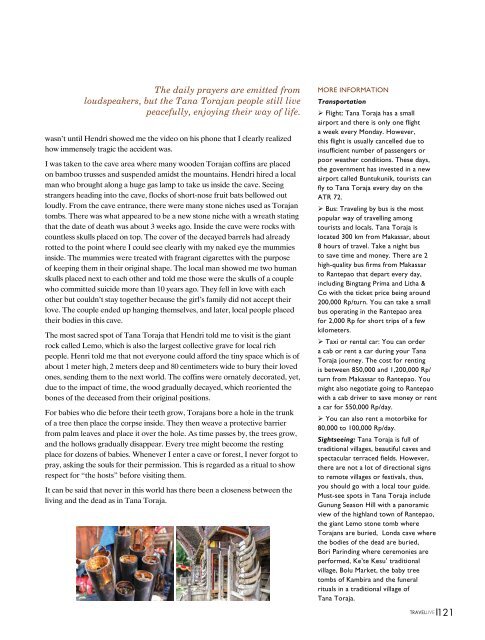Travellive 11-2018
You also want an ePaper? Increase the reach of your titles
YUMPU automatically turns print PDFs into web optimized ePapers that Google loves.
The daily prayers are emitted from<br />
loudspeakers, but the Tana Torajan people still live<br />
peacefully, enjoying their way of life.<br />
wasn’t until Hendri showed me the video on his phone that I clearly realized<br />
how immensely tragic the accident was.<br />
I was taken to the cave area where many wooden Torajan coffins are placed<br />
on bamboo trusses and suspended amidst the mountains. Hendri hired a local<br />
man who brought along a huge gas lamp to take us inside the cave. Seeing<br />
strangers heading into the cave, flocks of short-nose fruit bats bellowed out<br />
loudly. From the cave entrance, there were many stone niches used as Torajan<br />
tombs. There was what appeared to be a new stone niche with a wreath stating<br />
that the date of death was about 3 weeks ago. Inside the cave were rocks with<br />
countless skulls placed on top. The cover of the decayed barrels had already<br />
rotted to the point where I could see clearly with my naked eye the mummies<br />
inside. The mummies were treated with fragrant cigarettes with the purpose<br />
of keeping them in their original shape. The local man showed me two human<br />
skulls placed next to each other and told me those were the skulls of a couple<br />
who committed suicide more than 10 years ago. They fell in love with each<br />
other but couldn’t stay together because the girl’s family did not accept their<br />
love. The couple ended up hanging themselves, and later, local people placed<br />
their bodies in this cave.<br />
The most sacred spot of Tana Toraja that Hendri told me to visit is the giant<br />
rock called Lemo, which is also the largest collective grave for local rich<br />
people. Henri told me that not everyone could afford the tiny space which is of<br />
about 1 meter high, 2 meters deep and 80 centimeters wide to bury their loved<br />
ones, sending them to the next world. The coffins were ornately decorated, yet,<br />
due to the impact of time, the wood gradually decayed, which reoriented the<br />
bones of the deceased from their original positions.<br />
For babies who die before their teeth grow, Torajans bore a hole in the trunk<br />
of a tree then place the corpse inside. They then weave a protective barrier<br />
from palm leaves and place it over the hole. As time passes by, the trees grow,<br />
and the hollows gradually disappear. Every tree might become the resting<br />
place for dozens of babies. Whenever I enter a cave or forest, I never forgot to<br />
pray, asking the souls for their permission. This is regarded as a ritual to show<br />
respect for “the hosts” before visiting them.<br />
It can be said that never in this world has there been a closeness between the<br />
living and the dead as in Tana Toraja.<br />
MORE INFORMATION<br />
Transportation<br />
‣ Flight: Tana Toraja has a small<br />
airport and there is only one flight<br />
a week every Monday. However,<br />
this flight is usually cancelled due to<br />
insufficient number of passengers or<br />
poor weather conditions. These days,<br />
the government has invested in a new<br />
airport called Buntukunik, tourists can<br />
fly to Tana Toraja every day on the<br />
ATR 72.<br />
‣ Bus: Traveling by bus is the most<br />
popular way of travelling among<br />
tourists and locals. Tana Toraja is<br />
located 300 km from Makassar, about<br />
8 hours of travel. Take a night bus<br />
to save time and money. There are 2<br />
high-quality bus firms from Makassar<br />
to Rantepao that depart every day,<br />
including Bingtang Prima and Litha &<br />
Co with the ticket price being around<br />
200,000 Rp/turn. You can take a small<br />
bus operating in the Rantepao area<br />
for 2,000 Rp for short trips of a few<br />
kilometers.<br />
‣ Taxi or rental car: You can order<br />
a cab or rent a car during your Tana<br />
Toraja journey. The cost for renting<br />
is between 850,000 and 1,200,000 Rp/<br />
turn from Makassar to Rantepao. You<br />
might also negotiate going to Rantepao<br />
with a cab driver to save money or rent<br />
a car for 550,000 Rp/day.<br />
‣ You can also rent a motorbike for<br />
80,000 to 100,000 Rp/day.<br />
Sightseeing: Tana Toraja is full of<br />
traditional villages, beautiful caves and<br />
spectacular terraced fields. However,<br />
there are not a lot of directional signs<br />
to remote villages or festivals, thus,<br />
you should go with a local tour guide.<br />
Must-see spots in Tana Toraja include<br />
Gunung Season Hill with a panoramic<br />
view of the highland town of Rantepao,<br />
the giant Lemo stone tomb where<br />
Torajans are buried, Londa cave where<br />
the bodies of the dead are buried,<br />
Bori Parinding where ceremonies are<br />
performed, Ke’te Kesu’ traditional<br />
village, Bolu Market, the baby tree<br />
tombs of Kambira and the funeral<br />
rituals in a traditional village of<br />
Tana Toraja.<br />
TRAVELLIVE 121















